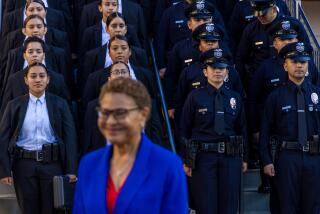Beatings Alleged to Be Routine at Rampart
- Share via
Anti-gang officers in the Los Angeles Police Department’s Rampart Division routinely and unnecessarily punched, kicked, choked and otherwise beat suspects in an effort to intimidate the gangs that the officers were charged with policing, according to confidential investigative documents and interviews.
The officers then fabricated elaborate stories in police reports, even planting drugs on a suspect, to account for their victims’ injuries, disgraced ex-officer Rafael Perez has told investigators, who are questioning him as part of his plea bargain to secure a lesser sentence on cocaine theft charges.
Although allegations of unjustified shootings are the most sensational disclosures Perez has made to detectives, he said that beatings were a far more common form of misconduct, involving many of the officers now under investigation in the growing scandal.
The beating allegations are part of an overall investigation into police crimes and misconduct in the Rampart Division. So far, the corruption probe has uncovered information about unjustified shootings, evidence planting and false arrests. More than 30 convictions have been overturned, and at least 20 officers have been relieved of duty, been fired or have quit because of the scandal.
In one case, records show, an arrested man’s badly bloodied face was explained away by officers as injuries sustained when he attempted to jump out of a third-floor apartment window head first.
Another suspect allegedly was used as a human battering ram, his head repeatedly thrust into a target drawn on a wall because he refused to disclose information about a gun officers were seeking, documents show. The young man told investigators that his head was pushed through the plaster and was pierced by splinters from the wooden studs inside the wall.
On many occasions the victims claimed their beatings were retaliation for having made complaints about CRASH officers’ misconduct to the officers’ supervisors. Gang members have complained that at other times, the beatings were inflicted by officers simply to harass gang members.
In one case under investigation, someone slashed the tire of a Rampart officer’s car. The CRASH unit, which suspected it had been done by a gang member, formed a posse. The officers allegedly drove around the neighborhood and indiscriminately beat suspects. One young man allegedly was dumped from his wheelchair into the street, according to police interviews.
Several gang members interviewed by The Times said there was one officer who enjoyed taking them into an alley and forcing them to participate in bare-knuckle boxing matches with him. The muscular officer would take off his gun and police belt and start throwing punches.
“He wanted to damage something,” said one gang member, who added that he and his friends had to let the officer win or they would suffer greater punishment.
‘He Was Just a Brutal Guy’
Perez alleged to investigators that two officers in particular--Brian Hewitt and Daniel Lujan--were well known among a group of Rampart’s rogue cops for administering street justice.
“Actually, [Hewitt’s] biggest forte was thumping people. He just had this thing about beating people up while they were handcuffed. That’s what he did. He was just a brutal guy. Between him and Lujan, that was their favorite thing. Just beat people up for no reason,” Perez told investigators.
Many of the beating allegations come directly from Perez. Transcripts of his interviews with investigators, copies of which have been obtained by The Times, are filled with sordid stories of officers physically abusing people. Although Perez has failed a polygraph test--an examination his attorney and a respected expert contend was critically flawed--many of the ex-officer’s allegations have been independently validated by LAPD detectives.
Hewitt, in fact, was fired by the LAPD for allegedly beating a suspect bloody on Feb. 26, 1998. The former Rampart officer is accused of grabbing Ismael Jimenez by the neck, shoving him against a wall and hitting him repeatedly in the chest and abdomen with fists.
Jimenez vomited blood in the interview room and staggered out of the police station, police documents show. He was later treated at a nearby hospital. Prosecutors, citing a lack of evidence, have twice declined to file charges against Hewitt. But the case remains under investigation and Jimenez has been subpoenaed to testify before a grand jury investigating alleged crimes by LAPD officers, sources said.
Jimenez, an 18th Street gang member, was allegedly beaten because the mother of another 18th Streeter filed a complaint against the officers who allegedly beat her son.
In an interview, LAPD Det. Patti Ferguson asked Perez what evidence he had that Hewitt was prone to using excessive force.
“I’ll give you a little story,” Perez began, recalling an incident in 1996, shortly after he joined the CRASH unit, in which Hewitt was in an interview room at the Rampart station with an 18th Street gang member.
Perez said he was sitting in the hallway talking to another gang member, looking into the room where Hewitt was conducting his interview.
“And all of a sudden Hewitt is choking a guy with his hands, making him talk. Choking him, just choking him. The guy’s looking like he’s about to pass out--just with one hand--he’s just choking the guy,” Perez said.
The suspect’s hands, Perez said, were cuffed behind his back. “I saw Officer Hewitt hit this guy so hard in the neck that the guy flipped backward and onto the floor.”
In fact, Perez said, Hewitt often seemed more interested in beating suspects than taking them to jail.
“Let’s say he catches you dirty, he would rather beat you up, beat you to a pulp, and then say, ‘OK, we’re even now, right?’ ” Perez said. “I’ve seen Hewitt beat up more people by himself than I’ve seen probably by the entire department put together.”
Perez added, “When all this [interrogation] first started I had said how I fear certain officers. . . . Hewitt is one of them.”
Two other officers implicated in the corruption scandal, as well as several gang members, told The Times in interviews that Hewitt was a violent officer.
An encounter with Hewitt, said one jailed gang member, was a guaranteed “butt-whupping.”
Lujan, who was charged but exonerated of wrongdoing in the Jimenez beating, also liked to “thump” people, Perez told interrogators.
He recalled a time that Lujan badly injured the knee of a man he had chased down during a foot pursuit near 11th Street and Burlington Avenue. When a sergeant showed up at the scene, Lujan said that “the guy got thumped,” Perez said. When Sgt. Edward Ortiz asked Lujan what crime the man committed, Lujan said he was unaware the injured man had committed any crime. In an apparent attempt to cover up the unjustified use of force, the sergeant told Lujan to book him on a drug charge, according to Perez.
Perez told investigators he also saw Lujan dislocate a man’s elbow at the joint during one arrest. The man, Perez said, was combative with officers and was suspected of being armed. At one point, Perez said, five CRASH officers were on top of the suspect, subduing him. Perez punched the man in the face, another officer squirted pepper spray on the man and Lujan separated the man’s elbow.
“You can tell whether you want to put somebody’s arm behind their back or you want to injure them,” Perez told investigators.
“You believe that Lujan excessively torqued his arm causing the dislocation?” asked Sgt. John Cook, a detective on the LAPD corruption task force.
“Yeah, you don’t just put someone’s hands behind their back and dislocate their elbow,” Perez responded. “You have to do something to it. And that’s what he did. He had placed his arm, lifted his wrist, and just took his elbow out of place.”
Differing Explanations for Suspect’s Injuries
Lujan and Hewitt are suspected of teaming up in another alleged beating on Feb. 21, 1996, when they arrested Rene Alfredo Canales on drug charges. Canales’ injuries were explained in a police report as occurring when the suspect “attempted to dive out the [third-] floor window, hitting the right side of his head [and] forehead on the window frame . . . got up and again lost his balance and fell forward while [attempting] to escape and hit his head numerous times against the metal balcony, arm rail and steps.”
But according to documents obtained by The Times, Canales claims he was sitting on a milk crate outside a third-floor apartment room, waiting for a friend, when officers converged on him.
Canales alleges that the officers, for no apparent reason, handcuffed him, threw him to the floor and started kicking him in the head, face and back. The officers stopped beating him when a sergeant approached, he said.
Perez implicated two other CRASH officers in the beating of a man who allegedly tried to kill an LAPD motorcycle officer with his car as he fled from a robbery. He was caught by officers as he attempted to flee.
“They had roughed this guy up while at the scene,” Perez said, referring to Officers Doyle Stepp and Omar Veloz, both of whom have been relieved of duty. “They kicked his butt pretty good.”
Veloz’s attorney disputed Perez’s account and said his client did nothing improper. Attorney Lawrence J. Hanna said the suspect resisted arrest and was high on drugs. He said other officers helped Veloz and Stepp take the man into custody and the suspect did not allege at the time of his arrest that he was mistreated.
Back at the station, Perez said, he witnessed abuse firsthand. He said he heard a commotion in an interview room and went to investigate, and saw Stepp releasing the suspect, Elvis Ponce De Leon, from a chokehold.
“When I walked in . . . he releases the guy, the guy falls on the chair and to the ground. And is out. He’s out unconscious,” Perez said.
Ponce De Leon was taken to a hospital, recovered, and was later convicted of assault and drug possession, documents show.
Perez said Stepp and Veloz subsequently told him about the initial beating.
“We don’t take too kindly” to attempted murder of a police officer, Perez said. “So, basically, you know, the thought was he got what he deserved.”
More to Read
Sign up for Essential California
The most important California stories and recommendations in your inbox every morning.
You may occasionally receive promotional content from the Los Angeles Times.











